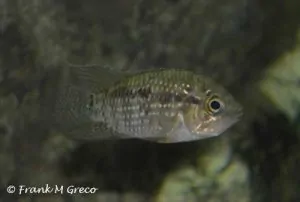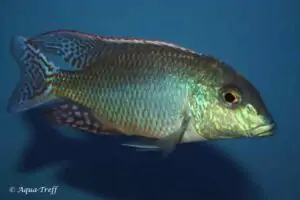Nandopsis tetracanthus – Cuban Cichlid
Nandopsis tetracanthus
Nandopsis tetracanthus was first described in 1831 by Valenciennes. The genus name Nandopsis is not explained in the description. It can be broken into two parts. “-Opsis-” means “resembling” and “Nando” may refer to the family Nandoidae or leaf fish. It is not known what he saw the resemblance in.
The species name tetracanthus also consists of two parts. “Tetra” means “four” and “acanthus” means “fin rays”. A reference to the number of anal fin rays of this species. It was initially thought to be a member of the Centrachus family, which has 7 or 8 anal fin rays whereas Nandopsis tetracanthus has only four.
Their common name is Cuban Cichlid, a reference to the origin of this species. In Cuba, they are called Biajaca
Description
This species can reach a maximum total length of about 30 centimeters. This applies to the males. The Nandopsis tetracanthus females remain a bit smaller.
The ground color of the male is white to beige. On top of that, they have black spots. Each scale seems to have a slight black edge. The females have a bit more color and markings (with some vertical stripes) than the males.
The color and markings differ from almost all other cichlids from Central America, so you will not easily be confused about the species. At most Parachromis managuensis looks a bit alike.
Are Cuba Cichlids Peaceful or Aggressive?
This species is aggressive towards conspecifics. You can keep them as a couple. Place a group of young Cuban Cichlids in an aquarium to form a pair. Once a pair begins to form, the pair chases all other fish out of their territory. Now is the time to remove the other congeners to avoid casualties.
Not all specimens are equally aggressive. Some can be kept with other small fish species. To keep them together with other large cichlids, a large aquarium is needed so that they can each form a territory.
Biotope
The name Cuban Cichlid suggests that they only occur in Cuba. They do occur there, of course, but also in Barbados, Haiti and the Dominican Republic.
They often occur in the freshwater parts of the fast-flowing rivers but also in small lakes. They mainly live in planted parts of the river. Occasionally they are also found in the brackish water estuaries.
Diet
The diet of Nandopsis tetracanthus in the wild consists of shrimp, worms, insects, and small fish. This was revealed by examining their stomach contents.
In the aquarium you can feed them with, for example, Mysis, krill, shrimp, and mussels, but also green food such as Spirulina flakes contribute to their health. For a change, you really do them a favor with a big fat earthworm.
The Aquarium
This large cichlid needs a spacious aquarium. For only one couple of Cuban Cichlids an aquarium is needed that is 250 centimetres wide and at least 60 centimetres deep and high. If you want to combine them with other large cichlids, we recommend a larger aquarium. They are generally more tolerant of fish that have been raised together from a young age than to fish that have been newly added. A few smaller species could be combined in an aquarium of 250 centimeters.
Set up the aquarium with (filter) sand on the bottom. Place some pebbles and boulders. Create shelters with some driftwood and a few spots that break the lines of sight.
Water parameters
Although this species is also found in brackish water, salt in the aquarium is not necessary to keep them healthy.
The temperature of the water may be between 24 and 30 degrees Celsius. The pH ranges from pH 6.0 to 8.0….reasonably neutral water is therefore fine.
Breeding aquarium and conditioning
From a very young age, females can lay eggs. The disadvantage of this is that the female stops growing afterward. The ideal conditions for breeding are therefore best created when the fish are fully grown. Provided they care about our efforts, of course.
Breeding Nandopsis tetracanthus requires a burrow in which they can lay the eggs. You can use a large flower pot for this, which you place on its side in the aquarium. This may also be partially buried. The fish will dig out the pot on their own.
Because the eggs and the young fish are very fiercely defended, you might consider setting up a special breeding aquarium. This prevents the eggs or young fish from being eaten. This also protects any other fish from the overly aggressive behavior of the parents.
The flower pot is completely cleaned by the parents before courting takes place.
The Spawn
When the female is ready to lay eggs, her laying tube protrudes. This is a sign that she is ready. The male swims in circles around the flower pot. He tries to seduce the female to lay eggs.
Once the Nandopsis tetracanthus female is really ready, she lays about 300 to 400 eggs (up to 600 eggs for very experienced females). These are fertilized directly by the male.
The female fans and guards the eggs. She continuously brushes them and removes any unfertilized or mouldy eggs. Meanwhile, the male guards the area and drives away any intruder very aggressively.
Beware, your hands are also intruders and they can lash out fiercely at your fingers. So stay away with your hands.
Raising the fry
Depending on the temperature and the like, the eggs hatch about 48 hours after spawning. The young fish then continue to feed on their egg yolk sac. They can swim freely for five days after hatching.
This is also the moment when the male changes color. He now takes the color of the female. The cloud of young Cuban Cichlids is fiercely guarded and protected by both parents.
You can feed the fry with freshly hatched brine shrimp. As soon as they are slightly larger, you give them larger, suitable food. They are not really picky eaters but they do need strong food to grow well. They grow fairly quickly, after about four months they are five to eight centimeters in size.
Conclusion
The Cuban Cichlid can be a centrepiece in your aquarium. With the correct setup of the aquarium and suitable fish, they are real eye-catchers. You have to take into account that they grow quite large and defend quite aggressively during spawning and care of young. Keep them only with either smaller species or other large robust species.
Video
Author
John de Lange
Copyright images
Jan Fioole
Ben Lee – Amiidae.com
Jeff Rapps – Tangledupincichlids.com
References
Fishbase.org
Qualitymarine.com
Practicalfishkeeping.co.uk
Nvcweb.nl
Etyfish.org








Reviews
There are no reviews yet.